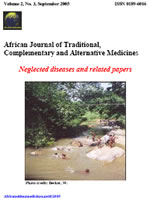
|
African Journal of Traditional, Complementary and Alternative Medicines
African Ethnomedicines Network
ISSN: 0189-6016
Vol. 16, No. 1-12, 2019, pp. 1-12
|
 Bioline Code: tc19001
Bioline Code: tc19001
Full paper language: English
Document type: Research Article
Document available free of charge
|
|
|
African Journal of Traditional, Complementary and Alternative Medicines, Vol. 16, No. 1-12, 2019, pp. 1-12
| en |
ANTIHYPERGLYCEMIC, ANTIOXIDANT AND ANTI-INFLAMMATORY EFFECTS OF AQUEOUS EXTRACT OF MISTLETOE ( Cladocolea loniceroides  ) IN STZ-INDUCED DIABETIC MICE ) IN STZ-INDUCED DIABETIC MICE
Ruiz, Frida Monserrat Hosanna Paredes; Barrera, Angeles Fortis; Alquieira, Edith Ponce; Pérez, Julio César Almanza; Ramos, Rubén Román & Santos, Jorge Soriano
Abstract
Background: Inhibition of carbohydrate hydrolyzing enzymes, such as α-amylase and α-glucosidase, is a key element in
the regulation of diabetes mellitus (DM). The purpose of this work was to study the inhibition of carbohydrate hydrolyzing
enzymes, and the antihyperglycemic activity of aqueous extract of Cladocolea (C. loniceroides) in streptozotocin (STZ)-induced diabetic mice.
Materials and Methods: The inhibitory activities of C. loniceroides aqueous extract on α-amylase and α-glucosidase were
investigated in vitro. Glucose tolerance test was performed in normoglycemic (NG) mice which were fed with starch or
sucrose. The effect of mistletoe aqueous extract (ME) was measured in (STZ)-induced diabetic mice. On day 35 of the
treatment, the effect of decreasing oxidative stress (lipid peroxidation, glutathione redox state, GPx and GR specific
activities, cytokines and aminotransferases analysis) was assessed.
Results: ME showed a competitive mode of inhibition for the carbohydrate hydrolyzing enzymes (CHE). The maximum
antihyperglycemic activity in mice was observed for the unripe fruit aqueous extract (UFAE) for α-amylase and stem
aqueous extract (SAE); for α-glucosidase due to the glycemic response reduction by 23% or 35%, respectively. UFAE
decreased malondialdehyde (MDA) 1.76 times; GSH/GSSG ratio was mantained (3.08 ± 0.66); GPx activity was reduced
(24%); IL-6 was reduced (18%) and the concentration of TNF-α (37%) was leveled with respect to the (STZ)-induced
diabetic mice; ALT and AST (liver transaminases) levels were nearly the same compared with those found in the NG mice.
Conclusion: UFAE of C. loniceroides exhibited the highest antidiabetic activity in (STZ)-induced diabetic mice.
Keywords
Diabetes mellitus; Cladocolea loniceroides; antihyperglycemic; antidiabetic; oxidative stress and α-glucosidase
|
| |
© Copyright 2019 - African Journal of Traditional, Complementary and Alternative Medicines
Alternative site location: http://journals.sfu.ca/africanem/index.php/ajtcam
|
|
